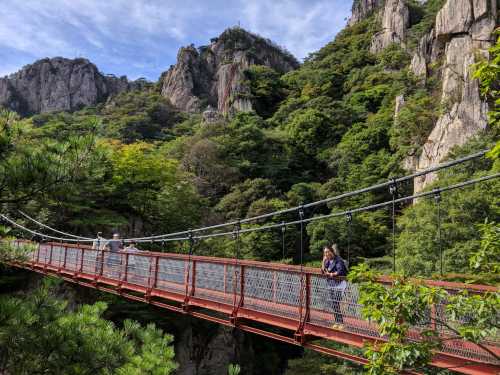Popular Trip Moments
A Peaceful Getaway at Maninsan Forest Retreat | This is the Ginseng Museum in Geumsan-gun, Chungcheongnam-do. | Geumsan Wolryeongsan Suspension Bridge | This is the Geumsan History and Culture Museum in South Chungcheong Province. | [Winter Indoor Date] Chungnam Geumsan Sky Water Garden Charcoal Kiln Steam Room Recommendation | I recommend a small cafe worth visiting in Geumsan~ | Geumsan Cafe Recommendation | Famous restaurants in Geumsan | A restaurant with a good atmosphere in Geumsan | Geumsan Restaurant | Recommended cafes in Geumsan with a good atmosphere | A place to make memories in Geumsan | A Vietnamese-style cafe with a famous honey bread restaurant in Geumsan | Honey Bread Restaurant in Geumsan | Recommended small cafes in Geumsan | Geumsan Cafe Recommendation | I recommend a place in Geumsan where you can make special memories. | Recommended cafes with a unique atmosphere in Geumsan | Geumsan Cafe Recommendation | I recommend a restaurant that serves delicious tonkatsu and sujebi~~~ | I recommend a restaurant in Geumsan that serves sujebi with a waiting list~~! | This is a famous Geumsan pajeon restaurant. | I recommend a good restaurant for sujebi | I recommend a delicious restaurant in Geumsan, South Chungcheong Province~~~~ | Geumsan Restaurant | Geumsan Waiting Restaurant | Come here to take a four-cut photo of Geumsan~! | A really pretty Geumsan pension near Daejeon! Cat World Pension🐱 | It seems to be the best among golf pensions.
Popular Travel Types
Recommended Attractions at Popular Destinations
Bangkok attraction near me | Manila attraction near me | Tokyo attraction near me | Taipei attraction near me | Hong Kong attraction near me | Seoul attraction near me | Kuala Lumpur attraction near me | Los Angeles attraction near me | Shanghai attraction near me | New York attraction near me | Shenzhen attraction near me | Osaka attraction near me | Singapore attraction near me | London attraction near me | Guangzhou attraction near me | San Francisco attraction near me | Beijing attraction near me | Macau attraction near me | Bali attraction near me | Jakarta attraction near me | Paris attraction near me | Ho Chi Minh City attraction near me | Istanbul attraction near me | Phuket attraction near me | Chicago attraction near me | Seattle attraction near me | Toronto attraction near me | Orlando attraction near me | Cebu attraction near me | Chiang Mai attraction near me
Popular Restaurants in Geumsan-gun
Sol Naeeum | Golmok Chueotang | Lotteria Guemsan Store | 코바코 | Insam Gol Haejangguk | Aewoldam | So Miyeon | Pig's Feet Jota | Sae Genuine Food | Oi Cow | Sura Gan | Beuniel | Ape a Dia | Red Clay Ribs | Yard Itneun House | Minam I Ne Table | Suna Restaurant | Du Dad Whole Chicken | Great Sage Restaurant | Pork Nation King Pork Belly | Ddochi Fried Chicken With Spring Onions | Wellbeing Kimbap Heaven | Simin Chinese Restaurant | Chujeong Noodles Soup | Oseong Jjajang | Garae Ol | Ginseng Eel Baektan Grill | Head Family House | Cart | Palbok Restaurant
Popular Ranked Lists
Popular Premium Hotels in Fahaheel | Top 4 Local Restaurants in Xinzheng | Popular Best Things to Do in Langfang | Top 10 Local Restaurants in Guangyuan | Top 4 Local Restaurants in Yichun | Popular Best Things to Do in Guang'an | Top 9 Local Restaurants in Nanchong | Popular Premium Hotels Near Douglas County | Popular Premium Hotels in Midland | Top 10 Local Restaurants in Shaoguan | Popular Premium Hotels in Mobile County | Popular Luxury Hotels Near Akhaltsikhe | Top 3 Best Things to Do in Fuding | Popular Best Things to Do in Ankang | Popular Luxury Hotels in Malargue | Popular Premium Hotels in Korcula | Top 4 Best Things to Do in Maoming | Top 3 Local Restaurants in Mengla | Top 10 Local Restaurants in Yueqing | Popular Best Things to Do in Panjin | Popular Luxury Hotels in Ramatuelle | Popular Luxury Hotels in Paradise Island | Popular Luxury Hotels Near East Brunswick | Top 10 Local Restaurants in Qionghai | Popular Premium Hotels in Tachira | Popular Best Things to Do in Ninghai | Popular Luxury Hotels Near Maggona | Popular Luxury Hotels Near Korcula | Top 9 Local Restaurants in Maoming | Top 3 Best Things to Do in Dezhou
Payment Methods
Our Partners
Copyright © 2025 Trip.com Travel Singapore Pte. Ltd. All rights reserved
Site Operator: Trip.com Travel Singapore Pte. Ltd.
Site Operator: Trip.com Travel Singapore Pte. Ltd.










































